Succulents are colorful and fun to grow. Many folks collect miniature species, like Echeveria, Haworthia, and Lithops, to display decoratively in their homes.
Gardeners in USDA Hardiness Zones 10 to 12 enjoy towering Agave, shrubby Aloe, and statuesque Yucca in their landscapes year-round.
And in Zones 7 to 9, growers cater to frost-hardy varieties, like ground-covering Sedum and Sempervivum.
What do all of these succulent growers have in common?
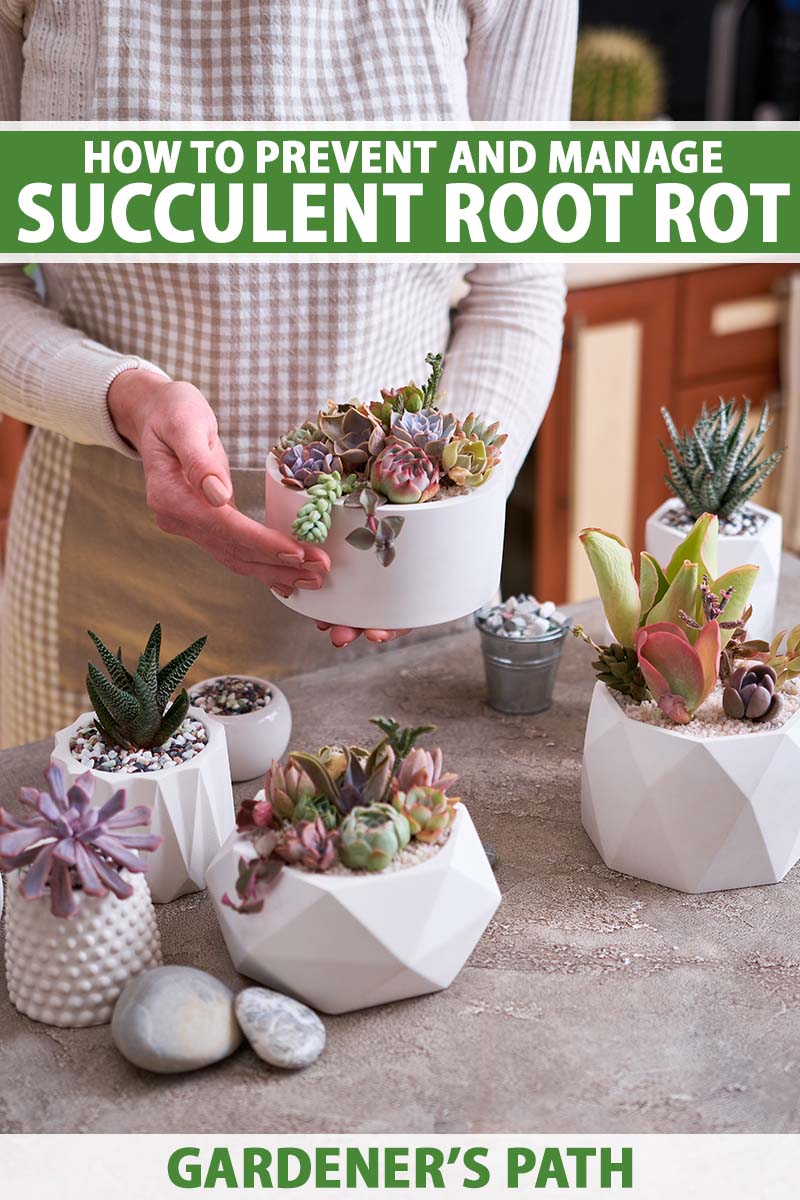
We link to vendors to help you find relevant products. If you buy from one of our links, we may earn a commission.
They all need to avoid the dreaded succulent nemesis: rotting.
In our guide to growing succulents, we share all you need to know to grow your own indoors and in a separate guide we cover cultivation outdoors in the garden.
This article discusses how to recognize, address, and avoid succulent rotting.
Here’s what we’ll cover:
What You’ll Learn
Let’s get started!
What Is Rotting?
Succulents are prone to rotting when the growing environment is too wet and the roots lack oxygen.
Poor drainage, overwatering, excess humidity, and compacted soil can cause water to pool, depriving roots of the ability to take up oxygen and nutrients.
The once firm, white roots gradually collapse, becoming dark, slimy, and soft.
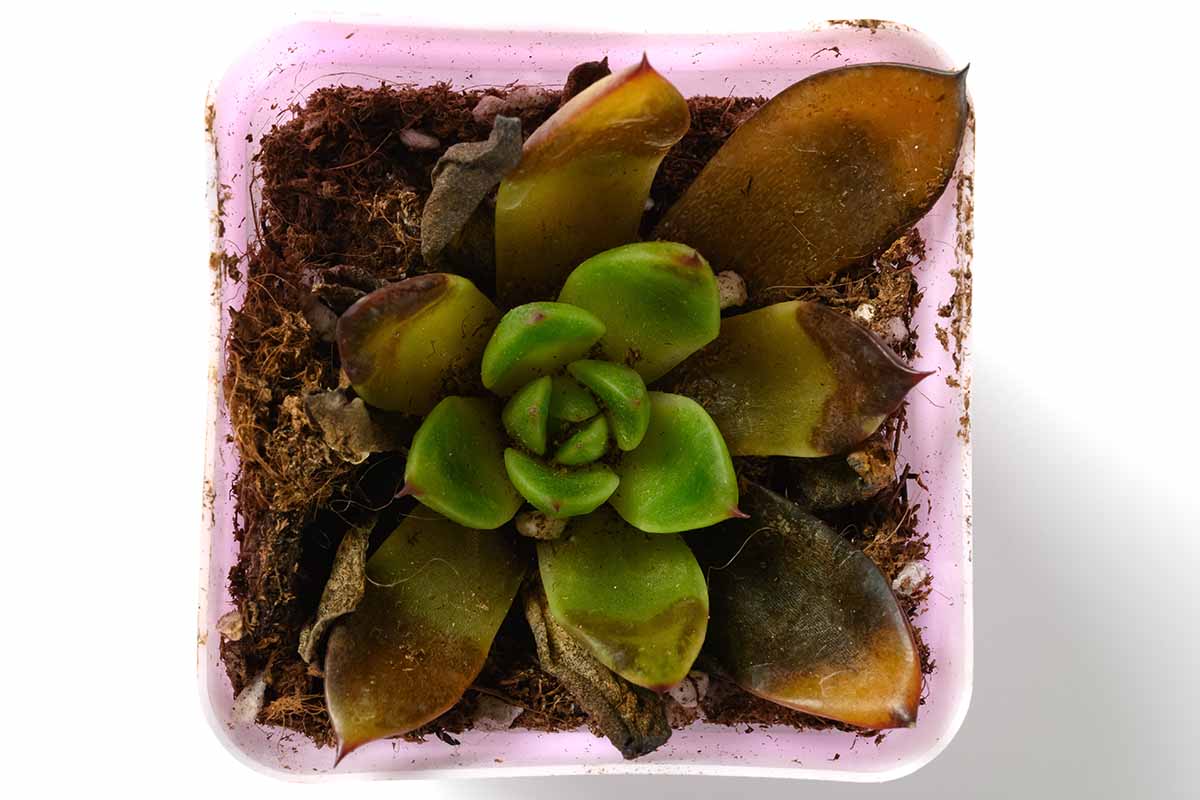
At first, the leaves may not show any signs of distress. Below ground, however, the soggy conditions activate soilborne pathogens that infect and further weaken vulnerable plants.
Gradually, excess moisture travels up through the stems, softening them and compromising their integrity.
You may notice the stems leaning, and discoloration of the lowest leaves as they, too, succumb to deterioration. The plump foliage may split, soften, and turn to mush, becoming pale, yellow, and then black, separating from the stems at the slightest touch.
In addition to those that attack at the root level, some pathogens activate on wet foliage, rendering it soft and watery before spreading into the stems and roots.
Rotting is irreversible. It’s best to dispose of decayed succulent plants and their potting soil in the trash. Although we will soon discuss fungicidal treatments, they do not cure decay.
Instead, they inhibit the spread of pathogens to healthy tissue.
It may be possible to take healthy-looking cuttings from a decaying plant to start new ones, but not knowing which pathogens are at work makes propagation risky.
What Causes Succulents to Rot?
As mentioned, some folks grow miniature succulents indoors, while others grow tree and shrub-like garden specimens in the landscape.

Depending upon the scope of your gardening, you may toss out a decayed plant and buy another, or you may want to try to treat a family treasure, removing only the affected portions, or as a last resort, take cuttings to propagate one or more new plants.
One of the most significant challenges is that it’s easy to recognize a mushy, pale plant that is failing, but not so easy to identify which pathogens are involved.
Numerous diseases can cause succulents to rot, including:
- Anthracnose
- Armillaria
- Bacterial Soft Rot
- Fusarium Wilt
- Phytophthora Root Rot
- Pythium Root Rot
- Rhizoctonia Blight
Let’s consider each type.
1. Anthracnose
Anthracnose (Colletotrichum spp.) is a group of fungal diseases that cause dark, watery lesions on the foliage.
Overhead watering that wets the leaves often activates the fungal spores. Unchecked, the damage may progress down the stems to the roots.
If you pick off the affected leaves before the damage is extensive, you may be able to save your plants. In addition, taking leaf and stem cuttings from sections unaffected by anthracnose may grow into healthy new ones.
Garden plants may respond to treatment with a copper fungicide, a toxic chemical that is suitable for outdoor use only.
Bonide® Liquid Copper Fungicide treats anthracnose, Phytophthora water molds (discussed below), and various bacterial blights.
Bonide Liquid Copper Fungicide
Bonide® Liquid Copper Fungicide is available from Arbico Organics in a 32-ounce ready-to-use spray, 16-ounce ready-to-spray hose end, 32-ounce ready-to-spray hose end, and 16-ounce concentrate.
Apply according to the manufacturer’s instructions.
To treat anthracnose on indoor specimens, you can try nontoxic neem oil, an organic fungicide, insecticide, miticide, and nematicide that may serve you well when cultivating a variety of house and garden plants.
Note that it has a strong garlic-like smell.
Bonide Captain Jack’s™ Neem Max
Bonide® Captain Jack’s™ Neem Max is available from Arbico Organics in 16-ounce and eight-ounce concentrate bottles.
2. Amarillaria Root Rot
Armillaria root rot (Armillaria mellea) aka honey or oak root fungus, is a fungal infection that typically affects oak trees, but succulents and other garden plants are not immune.
It causes stunting, wilting, and dieback. If your plants are affected by Armillaria you will typically see clusters of light brown mushrooms around the base.
There are no chemical controls, but an effective biocontrol option is to introduce Trichoderma fungi that feed upon Amillaria.
Trichoderma harzianum Strain T-22 is a biofungicide that suppresses disease and may prove effective as a preventative measure for gardeners who cultivate succulents outdoors on a large scale.
Mikrobs is a biofungicidal soil amendment that contains beneficial microbes, including Trichoderma harzaniaum, that stimulate root growth and compete with soilborne pathogens to facilitate nutrient uptake.
It combats Armillaria and a variety of blights that may plague succulents.
Mikrobs is available from Arbico Organics in packages containing eight ounces, one pound, five pounds, and 35 pounds. Treatments of this type are for outdoor use only.
3. Bacterial Soft Rot
Bacterial soft rot, caused by Erwinia carotovora, collapses stems, leaving plants water-soaked and slimy. The damage may not be as apparent at the root level because it is likely to be internal.
Bacterial soft rot is incurable. Dispose of affected plants in the trash. Do not take healthy-looking leaf or stem cuttings to salvage a specimen, as they likely harbor infection.
4. Fusarium Wilt
Numerous types of Fusarium oxysporum fungi cause Fusarium wilt. They penetrate vulnerable tissue, causing yellowing, stunting, and wilting.
The foliar symptoms occur before the root rotting, a signature sign of the disease. Unfortunately, there is no cure, and taking unaffected cuttings is ill-advised.
5. Phytophthora
Phytophthora are soil-borne pathogens that attack roots under excessively moist conditions and work their way up the stems of affected plants.
Phytophthora species are oomycetes, or water molds, that cause root rot for which no chemical cure exists. Its symptoms are yellowing, wilting, and dieback.
Using a copper fungicide, like the one mentioned above, may control the disease’s spread to unaffected foliage, and cuttings may be viable.
6. Pythium
Pythium water mold species destroy foliage by penetrating the root tips, blackening and collapsing them, before moving up into the stem aboveground. When a seedling is affected, this condition is known as “damping off.”
Repeated decay cycles may occur as the soil alternates between wet and dry, activating and deactivating the pathogen spores.
There is no treatment, and affected plants must be discarded in the trash, along with their soil.
Per the University of California Integrated Pest Management Program, the addition of 20 percent properly composted pine bark to potting soil may provide some control against Pythium and Phytophthora species, and the introduction of the mycoparasite Gliocladium virens to garden settings may inhibit Pythium activity.
7. Rhizoctonia Blight
Rhizoctonia solani causes rhizoctonia blight. It’s a soil-borne fungus that causes the damping-off of seedlings and root and stem rot.
You may know this disease as “brown patch” or “yellow patch,” turf disease.
Outdoor outbreaks may be successfully prevented or addressed by applying mycorrhizal fungi plus a biofungicide like Mikrobs, that I mentioned above, to the soil – or another product suited to both indoor and outdoor use, Bonide Revitalize® Biofungicide.
This product contains the beneficial bacterium Bacillus amyloliquefaciens which addresses blights, mildew, molds, and rots and can be used as a treatment or preventative.
Bonide Revitalize® Biofungicide
Bonide® Revitalize® Biofungicide is available from Arbico Organics in a 32-ounce ready-to-use spray, or 16-ounce concentrate.
Proactive Measures
As you can see, pathogens that prey on flora in overly wet environments are difficult to distinguish from one other, and once rotting occurs, it is irreversible.
Choosing to throw a plant away, pruning off affected leaves and stems, and taking cuttings to root are all ways to salvage a beloved specimen.

However, while biological and chemical treatments are available, they are merely controls and not cures, and none is a guarantee that the remaining foliage is disease-free.
The best way to address rotting is to avoid it altogether. Let’s learn how.
Quality plants, a healthy care regimen, and sanitary gardening practices go a long way toward avoiding decay.
Start by buying succulents from reputable purveyors. When the growers that supply them use sanitary practices, you multiply your opportunity for a successful growing experience.
If you are cultivating indoors, choose a location with a temperature between 55°F and 75°F and moderate humidity. Thirty to 50 percent is comfortable for most people and succulents.
Avoid overcrowding your pots so air can flow between the plants and the foliage, and keep them away from high traffic areas to avoid tissue wounds.
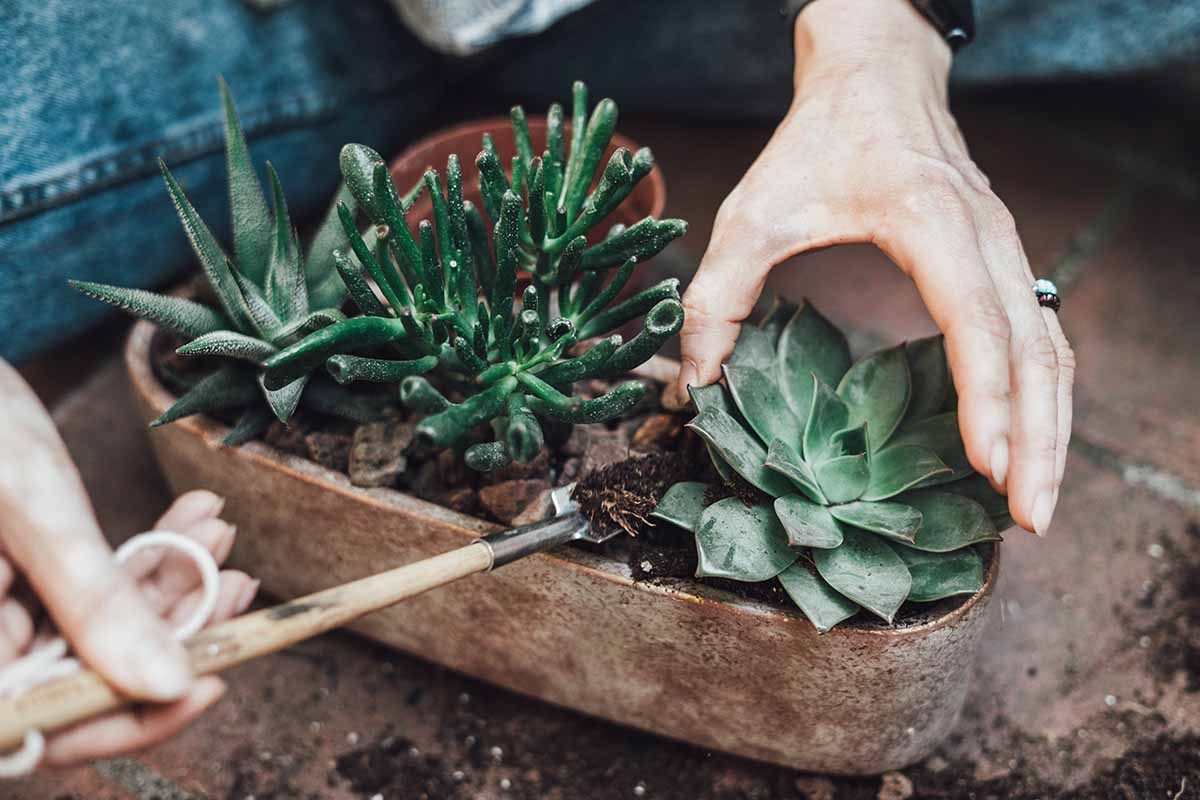
Provide bright, indirect sunlight indoors and full sun to part shade outdoors, depending on the species you are growing. Many pathogens prefer dark places in which to proliferate.
If you are growing in pots, choose those with ample drainage holes.
Sanitize them per manufacturer recommendations, or, for non-metal vessels, use a 10 percent water to bleach solution (one part bleach to nine parts water), and for metal, mild dish detergent and water.
Rinse well and dry thoroughly before filling with your potting soil.
Be sure to sanitize garden gloves, tools, and watering cans regularly. This is crucial to avoid spreading pathogens to healthy tissue when foliar decay occurs.
Use a quality moisture-retentive, well-draining cactus and succulent potting mix. It won’t compact and will release excess water. If you elect to use fertilizer, avoid products that are overly rich in nitrogen, as this can weaken cell walls and facilitate pathogen penetration.
When watering, wait for pots to dry out completely. A moisture meter can help you to judge when the time is right. Aim the spout at the soil to avoid splashing water and soil onto the foliage and creating a breeding ground for pathogens.
When potting rosette-style succulents, like Echeveria and Sempervivum, angle the foliage downward to facilitate water runoff of outdoor flora that gets rained on. Wet leaves are magnets for pathogens.
Consider applying a preventative fungicide to the leaves and/or soil per package instructions to lower the risk of rotting.
If it does occur, sanitize all tools, discard the affected plant portions and potting medium in the trash, and sanitize or dispose of the growing vessel.
Rotting is Irreversible, But Preventable
While you can’t heal decayed tissue, you can sometimes use a fungicide to treat the remaining healthy portions of a plant and the soil in which it grows.
Or, you may be able to take leaf or stem cuttings of unaffected portions to propagate new plants. And what’s best of all is that there are preventative measures to take to avoid rotting altogether.
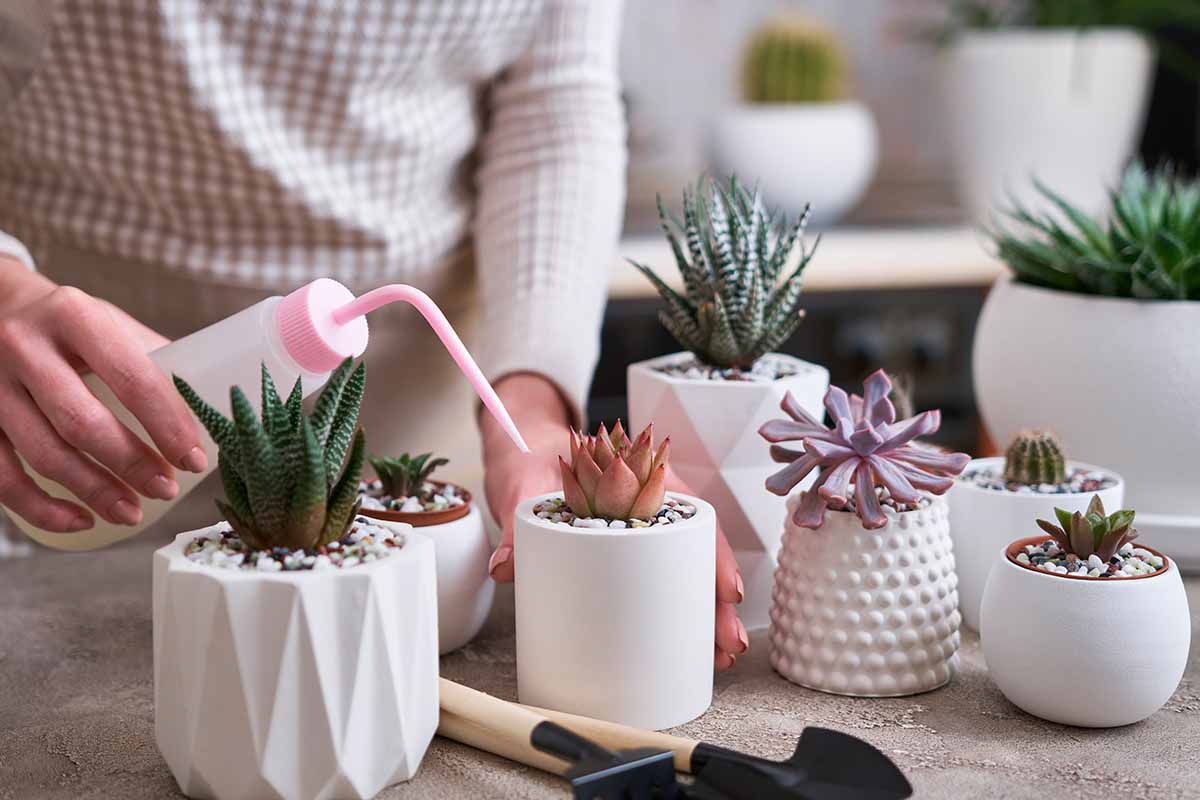
Succulents reward with various colors, shapes, sizes, and textures to delight outdoors in appropriate climate zones and indoors in all regions.
With best practices, they are long-lived, low-maintenance, water-wise wonders you’re sure to enjoy.
Do you grow succulents? Have you dealt with rotting? Tell us about your experience in the comments section below.
If you found this guide helpful and want to read more about succulent gardening, we recommend the following:

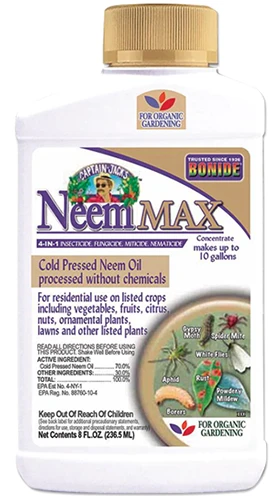


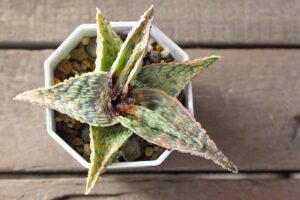
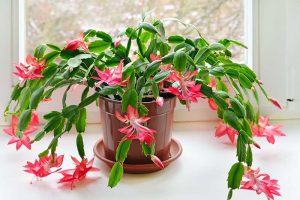

Hi Nan, very timely article! I have a Concrete Leaf plant (Titanopsis calcarea). However, I’m guessing because of our rainy & humid weather this year (in NJ, so we’re practically neighbors!), it’s losing a leaf here & there and not really thriving. I’s a slow grower so every leaf loss is a little setback. In March, I had un-potted it to add a little bit of organic material and the roots looked great. The plant’s on a table outside, under an umbrella. Would really love to have this little one thriving & happy so any tips would be great! Thanks,… Read more »
Hi Noel –
Our region is saturated and steamy for sure, and this is not the weather succulents thrive in.
Mine are indoors with a dehumidifier running. If you can relocate yours to a drier area and withhold supplemental water until it recovers, you should see improvement, although it will take time.
I’m so glad to hear you’ve been to Longwood. It’s an ever-changing botanical extravaganza!